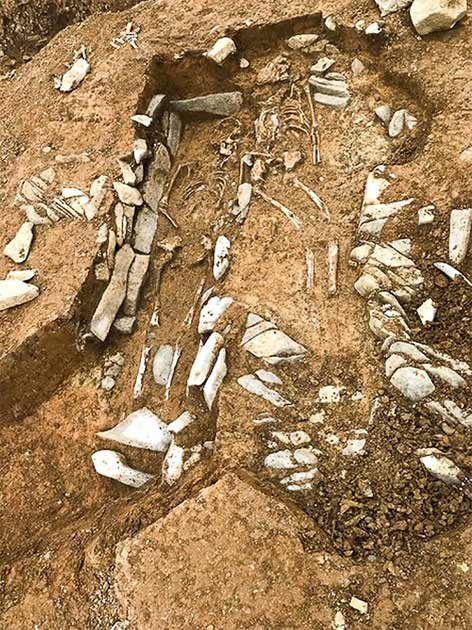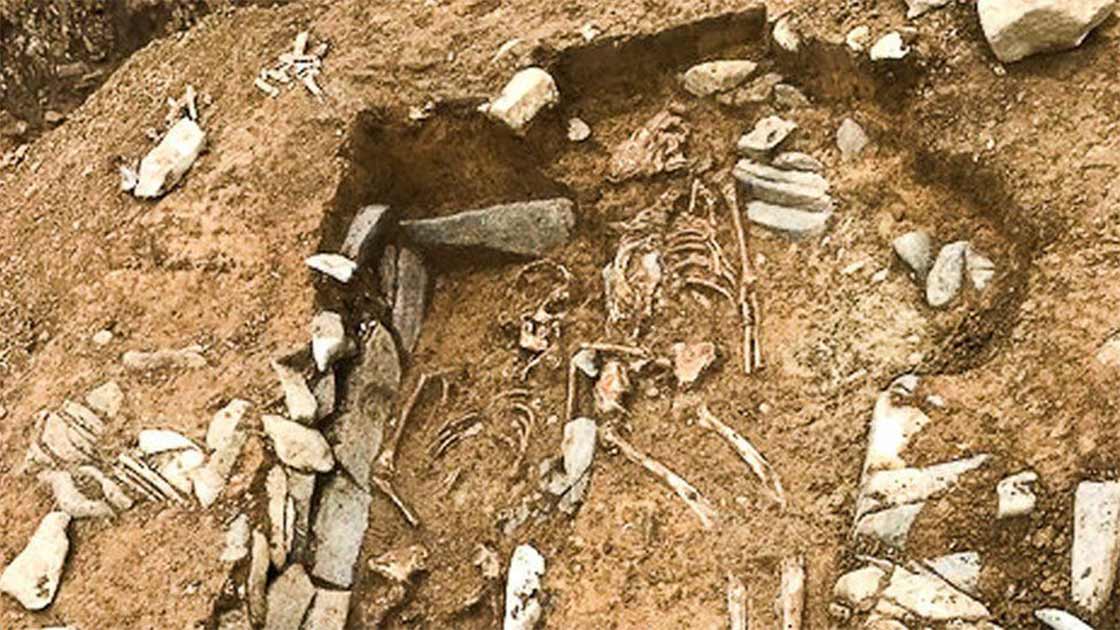Elite Roman Soldier Buried Face Down May Have Been Shackled
In 2022, a group of workers undertaking road improvements in Wales chanced upon the remains of a Roman soldier buried with his sword and regalia. But something was odd about this burial – the Roman mercenary was buried face down – a practice that was never a positive way of disposing of the deceased. Now new reports reveal that nails have been discovered near his neck, back, and feet, suggesting the soldier was also restrained at death.
Barry and District News UK reported that the discovery of the Roman mercenary, who was between 21 and 25 years old at the time of death, was made near Five Mile Lane close to the town of Barry in south Wales. The burial was excavated by Red River Archaeology and was found to date to between the 3 rd and 4 th centuries AD.

Archaeologists believe they have unearthed the human remains of a Roman Mercenary at the Five Mile Lane site in Wales. (Rubicon Heritage Services Ltd)
Unearthing a Roman Mercenary in Wales
Barry, a town in the Vale of Glamorgan, is located on the north coast of the Bristol Channel, in the southeast of Wales. Roman presence here is not unsurprising because of previous discoveries, including several farmsteads on the site of Barry Castle and Biglis, and a magnificent 3rd century Roman 22-room building, with cellars, a central courtyard which was discovered in 1980. The find at Glan-y-mor was believed to be associated with naval activity, a supply depot perhaps.
- Artifact-Rich Ancient Roman Village Unearthed By UK Archaeologists
- Archaeological Finds Tell the Story of Wales’ Holy Island
“It’s great to learn that the archaeological study at Five Mile Lane has uncovered such a detailed history of the area,” said Emma Reed, head of neighborhood services and transport, when discussing the current find.
The excavations at Five Mile Lane uncovered what has been termed a “multi-period landscape” with various human settlements dating back to the Neolithic period, before it became a “wealthy Roman farmstead,” explained the Story Map Tour of the site. Amongst the finds, archaeologists unearthed the remains of a Roman mercenary, along with his sword and a silver crossbow-style brooch, which was likely used to fasten a cloak. The boorch suggests the solder was an elite member of the Roman military.

The silver brooch found buried with the Roman mercenary. Credit: Amgueddfa Cymru – Museum Wales)
Restrained at Death?
Live Science reports that the Roman soldier was found with large nails near his neck, back, and feet, which may indicated that he was restrained at the time of death. The fact that he was also buried in a prone position, i.e. facedown, also raises questions about the circumstances of his death. Prone burials were normally reserved for criminals or individuals that were disgraced in some way. It is curious that the mercenary was, nevertheless, buried with his sword and official regalia.
A nearby grave was also previously found containing the remains of a decapitated individual whose skull was place at their feet. Were they two Roman soldiers who committed a criminal act that made them deserving of such burials?
The Romans and their Conquest of Wales
This entire Welsh region did not exist in the way we know it today – in fact, there was no Wales geographically. The entire region consisted of Celtic peoples, organized into many tribes, who as such shared no social or political unity. Even when the Romans arrived, they did not give the geographical area any distinct name or identity.
When the Roman forces began their conquest of Britain in 43 AD, it would be only five more years before they reached the borders of current day Wales, writes Ben Johnson for Historic. The conquest of the region would take another 30 years, and was completed by 78 AD. The Romans stayed in the region till almost the end of the 4th century – 383 AD to be precise.
One of the Celtic tribes who violently opposed the Romans were the Silures, incidentally from the southeast Wales region. They valiantly defended their land between 49 and 75 AD, but eventually could not match the firepower and terrestrial strength of the Roman army.
The traditional way of living and habitation for the Welsh tribes, were circular timber farmhouses, reports Barry.cymru. The Romans introduced substantial stone houses, which became the dominant mode of architecture by the 2nd century. The elites would replace these with fully fledged villas with amenities like central heating, baths, wall plaster, mosaics.
In this particular area, the Romans would also build several roads, something that they were noted for during their reign. Nowadays several roads have been built in the area, including the arterial A48 that runs through the heart of Vale of Glemorgan. In and around these roads, several important archaeological discoveries have been made including Roman coins, jewelry, and sometimes weaponry.

Archaeologists also uncovered the remains of a Bronze Age burial monument. (Rubicon Heritage Services Ltd)
Top image: Skeletal Remains at Five Mile Lane near Barry in Wales. Source: Rubicon Heritage Services Ltd
By Sahir Pandey




















Comments
Just like to point out that literally just up the road is Bonvilston, bit of research indicated it was the site of a large Roman camp
Just like to point out that literally just up the road is Bonvilston, bit of research indicated it was the site of a large Roman camp